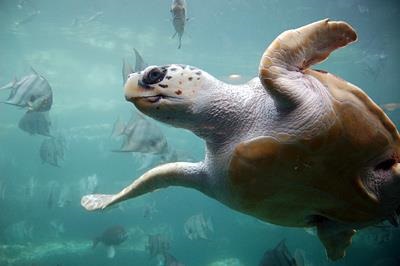New fishing techniques, equipment can help sea turtles
8 June 2010, Rome - Sea turtles have swum the seas for almost 60 million years, but decreases in their populations over the last century have many observers worried that long history could soon be coming to a close.
A wide range of human activities imperil these gentle giants. One of them is fishing: turtles are accidentally captured in nets or on hooks — a phenomenon referred to as "by-catch" — and often die before they can be released.
Exact numbers for sea turtles lost to fisheries by-catch each year are hard to come by, but it's generally agreed that by-catch of certain species - the Pacific loggerhead, the Pacific leatherback, and the Eastern Indian coast olive ridley, in particular - is a problem.
Fishing is not the only factor playing in to sea turtle deaths. Coastal development is destroying fragile turtle nesting areas. And turtles also consume litter — in particular discarded plastic bags, which look like the jellyfish they normally eat -- and die as a result.
But fisheries is an area where the know-how and equipment needed to reduce turtle deaths does exist, says FAO — and where there is tremendous opportunity to tackle that problem.
New guidelines can help
The UN agency is highlighting this message on the occasion of World Oceans Day 2010 by promoting the use of a new set of Guidelines to Reduce Sea Turtle Mortality in Fishing Operations.
The guidelines build on global efforts aimed at developing techniques that reduce sea turtle mortality due to fisheries and show that often-simple changes in fishing techniques and practices, coupled with the use of "turtle-friendly" technology, can make a difference. It includes drawings and diagrams that can guide fishers in taking onboard its suggestions. The various methods are categorized according to the type of fishery to which they are suited and the advantages and disadvantages of each method are summarized for ease of reference.
"These guidelines provide information about how to change gear and fishing methods, and how the industry can adopt voluntary approaches to reduce sea turtle mortality," said Gabriella Bianchi of FAO's Fisheries and Aquaculture Department. "They also make suggestions about management actions, like by-catch fees, as well as best practices such as hotspot avoidance, proper handling and release, and reducing derelict fishing gear."
One proven technique is to replace traditional "j-style" hooks with "circle hooks," which are not easily swallowed by turtles. More careful selection of bait to avoid foods favoured by turtles and dying bait a different colour can reduce by-catch as well. Slightly changing the depth at which hooks are set and installing "escape hatches" and "turtle excluder devices" on nets are other strategies recommended by the guidelines.
The theme of World Oceans Day this year is "Our Oceans: Opportunities and Challenges".
